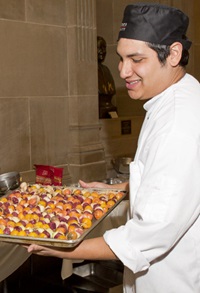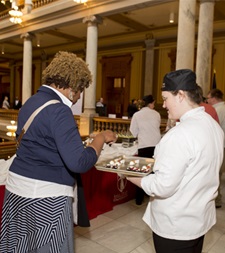Zac Denney focuses on a cooked chicken breast atop his cutting board. The resident of Wabash, Indiana, who expects to graduate this summer, carefully slices against the grain to create half-inch portions that will star in a dish with apricot jam, havarti cheese and prosciutto on crostini.
At the other end of four 6-foot folding tables, Rachel Dobrzykowski creates small cups of creme brulee, a custard she completes with a tiny tasting spoon and crisp caramel decoration.
“I grew up in a family where food brought us together,” said the South Bend, Indiana, woman who got her degree in May, continuing to work as she talks about what drew her to the culinary world.

Photo by Don Rogers
Joseph Palacios transfers a tray of nicoise skewers he prepared onto a holding rack before the reception.
Normally, these hospitality and food management majors would have been in one of Ball State’s fully equipped, well-lighted lab kitchens. On this spring day, they are in a third-floor hallway of the Indiana Statehouse, preparing to cater a late-afternoon hors d’oeuvres reception.
With few words, seven hand-picked students steadily work in a building that’s rarely silent. Leading them is Matthew Chappell, a highly organized, soft-spoken instructor who belies bellowing TV chefs.
“This will be something special for their resumes,” he said before the event. “And it shows students that off-site catering always has challenges.”
Addressing potential problems
The reception, after an address by Indiana higher education Commissioner Teresa Lubbers, immersed students in entrepreneurial learning through creativity, risk-taking and problem-solving.
Food preparation is at heart creative yet risky, and producing great food and flavors in a marble-floored public thoroughfare meant students and Chappell had to determine possible difficulties and bypass them.
“I learned a lot, from cooking and prepping the food beforehand to setting up and beautifully presenting the food on the trays.”
— Joseph Palacios
hospitality and food management major
For instance, creme brulee is traditionally baked, then topped with sugar that’s caramelized using a small torch. Because the hallway lacked ovens, and no one wanted to start a fire in the Statehouse, this sweet version became a stirred custard topped with caramel crunch.
Having no oven was part of the biggest issue: the lack of things, including easy access to running water (well, there were the bathrooms …), sinks and cooktops. So all prep work was done on-campus, Chappell said, mostly the day before the reception.
The next morning, they drove to Indianapolis and assembled everything as various people, including the lieutenant governor, walked by.
Another issue was having to work in soft, minimal light, thrown from huge chandeliers anchored more than 20 feet overhead.
Still, Joseph Palacios said later, the experience was great.
“I learned a lot, from cooking and prepping the food beforehand to setting up and beautifully presenting the food on the trays,” said the Ellettsville, Indiana, resident who expects to graduate this summer. “I'd encourage every student in (the program) to take advantage of any catering events that need volunteers just to gain firsthand knowledge.”
Getting everything ready
About 45 students graduate from the program each year, said director Deanna Pucciarelli, with those focused on food management often becoming food and beverage managers in restaurants. The majority of students seek jobs in the meeting and events sector rather than food.

Photo by Don Rogers
Mallory Bowman serves a guest from a tray of caprese “salad” and watermelon with feta cheese.
At the Statehouse, students did both the food and set up the reception area.
Three students gracefully arranged linens atop a long line of buffet tables and pinned them down the tables’ sides to create an elegant look. Smaller tall round tables also needed linens before people mingled; then the buffet tables got tidy piles of small plates and napkins before hors d’oeuvres were put out and arranged.
“My family loves food. I’ve been into food since high school (in Fort Wayne),” Lauren Jones, a senior who expects to graduate in December, said as she helped skirt the tables. “And I love talking with people. There’s a lot of talking in food management,” she said, smiling as she worked her first reception.
Communication is key for food and beverage managers. They discuss menus with executive chefs, track and order food and beverages, promote the restaurant and perform other tasks.
The Statehouse menu was varied and inviting — from a caprese salad served in a Japanese tasting spoon to deviled eggs with guacamole filling to vegan black lentil brownies.
“I’m trying to show off what we can do but keep it simple for us to do,” said Chappell. “I don’t think good food has to be complicated.”
Normally, students plan and develop an event menu during a semester, he said, offering ideas or recipes. This time, with a brief month’s notice, he took on those responsibilities.
It’s a chemical thing
One unusual menu part was the main basil in the caprese salad. Instead of basil leaves, students created jelled bubbles of basil, also called basil “caviar.” They’re referred to as caviar because, when eaten, they pop like the tiny fish eggs.
“My family loves food. I’ve been into food since high school. And I love talking with people. There’s a lot of talking in food management.”
— Lauren Jones
hospitality and food management major
“Food’s a science, not as much an art, to me,” Chappell said. “There’s art, of course, in plating. But if I can understand the chemistry of food, it lets me play with it a little more.”
The process is called caviar spherification, and here’s how it’s done.
Students blanched and pureed basil leaves, then mixed the puree with simple syrup (equal parts water and sugar). They added seaweed sodium alginate, which creates a gel when it meets calcium. After readying a bath of calcium chloride, they used a squirt bottle to drop basil syrup into the bath, where it jells.
At the Statehouse, Chappell showed Dobrzykowski the process.
She carefully squeezed out about 25 drops into a wire mesh strainer submerged in the calcium chloride, waited 30 seconds or so, transferred the jelling drops to a bowl of water to stop the jelling, tapped the strainer gently on a towel and deposited the jelled basil bubbles in a third bowl. When they hit the metal, they clinked.
A successful day
Guests and students both were a bit shy at first but ended up interacting. Erica Wiley, a May graduate from Fishers, Indiana, has seen that during about two years of working for University Catering. “Sometimes,” she said, “they almost apologize for taking the food. But it’s there for them.”
One gentleman was not reticent about how much he liked the carbonated apple juice “shooters” that contained slivers of pickled seedless red grapes. After ensuring there wasn’t any alcohol in the tiny drinks, he tentatively tried one, then enthusiastically declared, “I think I’ll have 10 to 15 of those.”
The only disappointed guests were those who missed the deviled eggs with guacamole filling (a student’s idea). “I heard they were gooood,” said one.
Dobrzykowski, who has an associate degree from Johnson & Wales University (noted chef Emeril Lagasse is a fellow alumnus), and the other students appreciated the chance to use their skills while learning.
Afterward, she said, “Ball State's hospitality program has provided me with many opportunities to build experience toward my career. I feel like Ball State especially has worked hard to highlight its students, and it's great feeling like your university invests in you.”
 Have a flair for food?
Have a flair for food?
Part of the Department of Family and Consumer Sciences, Ball State's degree in hospitality and food management is a terrific way to reach upper-level positions in food and beverage management, hospitality management and event planning.
Learn more about the hospitality and food management program.
By Judy Wolf, Editorial Manager